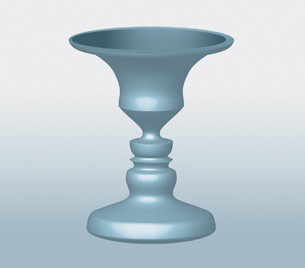Module 1
1. Module 1
1.19. Lesson 4
Module 1—The Nervous System
Lesson 4—Sensory Perception—Taste, Smell, Touch, and Temperature Sensations
 Get Focused
Get Focused

Do you see a plate, or do you see circles?
In the Big Picture your attention was grabbed from across the crowded room by a student who was new to your school. Perhaps it was her happy laughter that caught your attention. You decided that you’d like to meet her, so you approached the group she was with. The room suddenly seemed a lot warmer, and you felt sweaty. When you were introduced, you extended your hand for the shake. Her skin felt cool for a short moment, but then you withdrew your hand in pain.
Now you’re embarrassed and the room really feels hot! All this is increasing your breathing rate and heart rate, but the friend you’re with doesn’t seem as agitated as you are. Your friend doesn’t seem stressed or interested in meeting the same person. Your friend’s perception is quite different from yours.
In this lesson you will explore some of the senses that help maintain homeostasis by responding to environmental stimuli, both external and internal. In Lessons 5 and 6 you will explore the very important senses of sight and hearing. Sensory receptors, which are specialized neurons, receive stimuli such as taste, smell, touch, and temperature. You will learn about the special receptors for these senses and how they communicate information to the brain for processing.
You will also examine how the brain processes information differently depending on your experiences. Accident investigators are often frustrated by vastly different eyewitness accounts of the same accident. One person’s perception can be very different from the perception of another person who saw exactly the same event. What do you see when you look at the image below?

Do you see a wine glass, or do you see faces?
In this lesson you will investigate the following focusing question:
- What information about the environment do the senses of touch, smell, and taste communicate to a person’s nervous system in order to maintain homeostasis?
 Module 1: Lesson 4 Assignment
Module 1: Lesson 4 Assignment
Download a copy of the Module 1: Lesson 4 Assignment to your computer now. This assignment is comprised of a lab where you will have the opportunity to choose between the senses of touch, taste, or smell. You will design your own lab to examine the characteristics of one of these senses. You will receive further instructions about how to complete this assignment later in the lesson.
You must decide what to do with the questions referred to in this lesson that are not marked by the teacher. There are also additional questions in the textbook that you may choose to complete to support your learning. Discuss your work with your teacher at any time.
Remember that these questions provide you with the practice and feedback that you need to successfully complete this course. You should respond to all of the questions and place your answers in your course folder.
You may choose to summarize the information from this lesson in notes, concept organizers, charts, diagrams, or podcasts. Store your work in your course folder.
As you work through Lesson 4, continue to work on your Module Assessment. Research the relationships between Alzheimer’s disease and interruptions in a person’s ability to interpret taste, smell, touch, and temperature. Store any relevant findings in your course folder.
Before you begin Lessons 4 to 6, you may wish to read Chapter 12, on pages 404 to 433 in your textbook, for an overview of the material these lessons will cover.